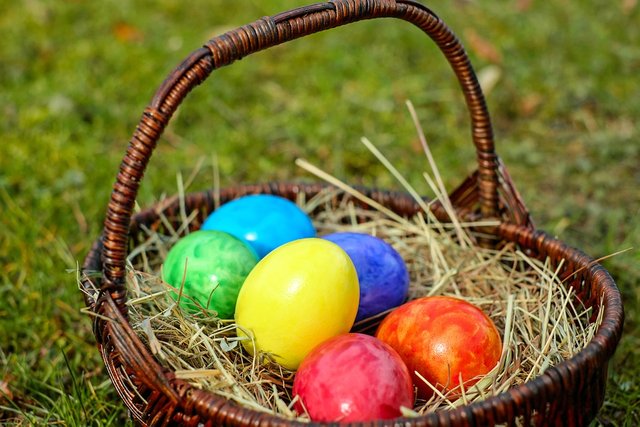Easter is not religious! - Same word, different things.
Christians or not, we all know about this holiday: Easter. The perfect excuse to take a few days off (where it is a non-labor day: like my country Argentina. Thursday and Friday scratching my balls!), for some people it is a day where faith is renewed... The thing is: Faith in what?

Many christian holidays have a basic standard of celebration where only the meals prepared differ. In the case of Easter, we can observe the incomplete process of assimilation of pagan cultures into the repertoire of one of the predominant religions today.
Basically, it celebrates the "beginning of Christianity" and the events that lead into the death of a magic carpenter.
Lets take a look at how different cultures look at it.
Easter and the cannibalized traditions
Of course, as any other christian holiday, Easter is a revamp of other religious festivities that had little to do with crosses, misogyny, acceptance of slavery and obligation to "adore or you'll go to hell to suffer for an eternity... because I love you". Not even the origin of the word to define it is "christian".
The name
In the majority of languages except English and German (Curious thing, anglo-saxons invaded Britain 1600 years ago... Yet easter is supposed to be over 2000 years old... Until the 7th or 8th century, there's no mention of "Ēostre" by Bede), the word for Easter (Pâques, Páscoa, пасхи → Pasky, Pasen, Paşte, Paskalya, Påsk, Pasqua, pääsiäistä... and the list goes on...) derives from the Jewish word Pesach, you guessed it: that is how they call Easter. It is a religious festivity that as many other jewish ones, got cannibalized by Christianity. The Jewish Easter lasts 7 or 8 days and it serves to remember the Exodus and freedom of the permanently-oppressed-jewish-people from the Pharaoh's grasp (thank Imhotep/Joseph for that).
English and Germanic, have a totally different root. It turns out that there was a monk, Bede, that loved writing everything down... At such point that he is considered the Father of British history!
He wrote (quoting wikipedia here) " that Ēosturmōnaþ (Old English 'Month of Ēostre', translated in Bede's time as "Paschal month") ". This was an English month equivalent to April, "was once called after a goddess of theirs named Ēostre, in whose honour feasts were celebrated in that month". One has to consider that he may've made up the whole story just to explain a single word. But if some people believe in magic carpenters, others in turncoat slavemasters that open dry paths of land in the middle of the black sea... We can believe in a Germanic Goddess, can't we?
There's no rule that forces you to like one comic book or another. (I like Marvel)
Jewish origins
A text from the begging of the 2nd century claims that it is an early christian celebration. But you know, as any large company, CEOs may have some personal issues against each other and argue for the smallest things. So, not ever they were unanimous!
(Recommended read: Easter Controversy)
Germanic roots
Borg, in case you don't know it. - Source: Memory Alpha
There's no doubt that there's plenty of pagan residues among the christian faith, this borg-like assimilation made it a lot easier to gather followers by slowly transitioning them into the mindless lines of happy "votive offerings" contributors. At any place if the world, it was impossible for the christian overlords to totally delete the most important traditions of each culture, so they had no choice but to improvise a holiday, assign it a saint and say that it was "christian all the time" to the poor ignorant folk.
Ēostre, was the Germanic goddess of spring and light. It was a festival that celebrated the Spring Equinox, march 21st, celebrating the end of cold and prevailing darkness. The return of life after a period of bitter cold and death.
Easter symbols

Part of the chosen symbols was the rabbit, adopted as a symbol of fecundity (because, we know how much they enjoy reproducing), until today... countless amount of bunnies are used as main theme of a holiday they don't give a fuck about. This occidental Europe traditional element was never accepted by orthodox Christians (they never figured out a way to seamlessly assimilate it).
Colored eggs brought by the Easter bunny as symbols for fecundity and rebirth. Children at several locations in the world color and hide Easter Eggs. Yet, this is also of "pagan" origin that prevails under Christianity.
Religious traditions around Easter
In the US, Norway (correct me if I'm wrong @fyrstikken) and the Czech Republic, the celebration of these holidays bring along some traditions that are far off their religious meaning. In the Us, for example, Easter became a commercial phenomenon where participants from several religions participate.
The sense of Easter was deformed into a children's celebration. Easter eggs are sold under different packaging, from the traditional chocolate (chocolate, american... far from Europe) egg, to an unaccountable amount of toys. The Germanic tradition of decorating and hiding eggs was adopted, this is done during the Friday, to begin the "hunt for eggs" during Sunday morning. Children are told that the eggs were hidden by the Easter Bunny, along with other goodies... Children are expectant for the prices to be found.
In Norway, Easter traditions include skiing and the colored eggs that are placed to decorate. Yet, they add up a curious element into the mix: it is a tradition to "solve" murder cases during Easter (crime fiction). All the main TV channels broadcast detective and crime stories; magazines publish some too, where the reader may attempt to find out who the guilty murderer is. There's several new books published too. Even milk cartons have murder stories printed on their sides.
Finally, in the Czech Republic, the tradition is rather... aggressive. It is performed during Easter's week Monday, when men beat women up with an especially hand-made whip called pomlázka. The El pomlázka consists in eight, twelve or even twenty-four willow sticks, from half a meter to 2 meters long, adorned with colored ribbons in one tip. while the beating may be painful, the purpose is not to cause suffering. This rite is somehow a primitive mating rite, where men exhibit their attraction to women by beating them up... Some women that do not get struck, may even feel offended. The struck woman gives a colored egg to the perpetrator as a display of forgiveness and gratitude. A legend says that women have to be hit so that they may be healthy and fertile during the upcoming year. Women that were struck may get revenge later, while their turn of dumping buckets of cold water at any man. This tradition slightly varies from one territory to another across the country.

So, as we can see, Easter is FAR from a religious festivity, not even their roots or current traditions uphold any similarity with what the dark ages progenitors meant for it. We should all enjoy our different customs with family and friends... Even when they are paronymous.
Edit:

